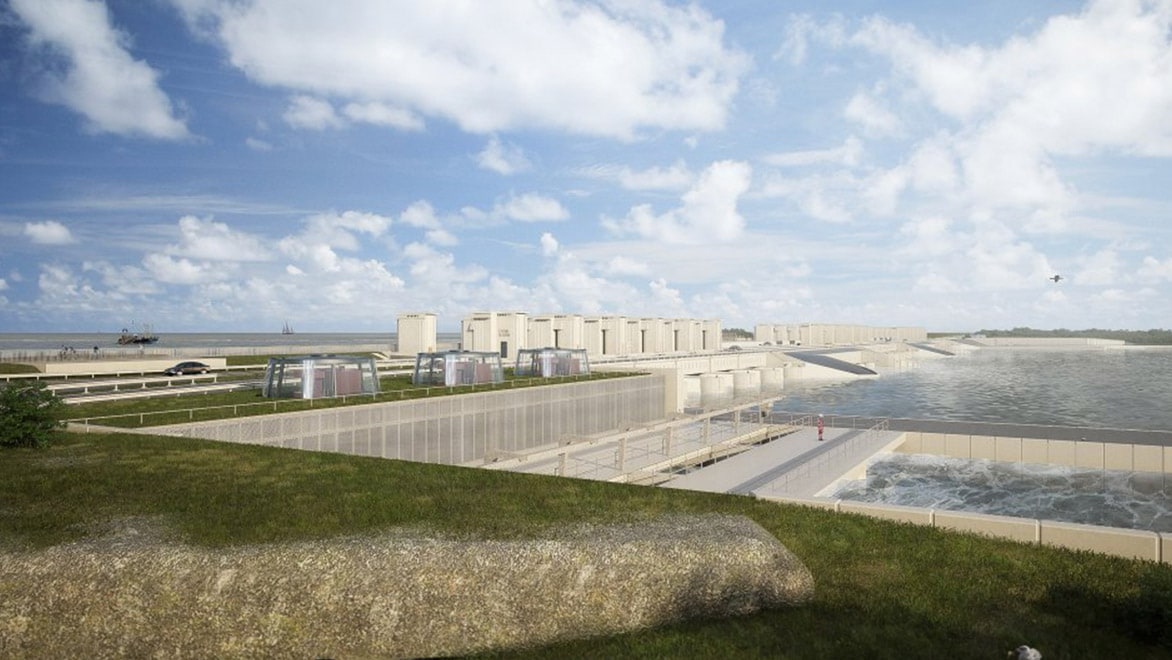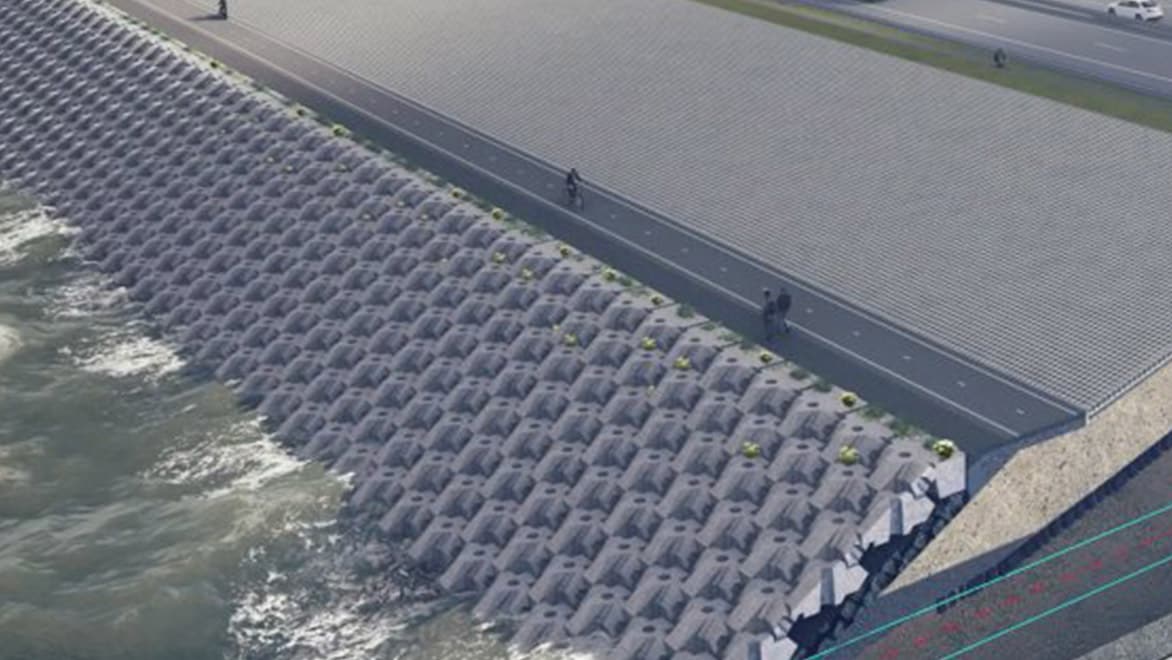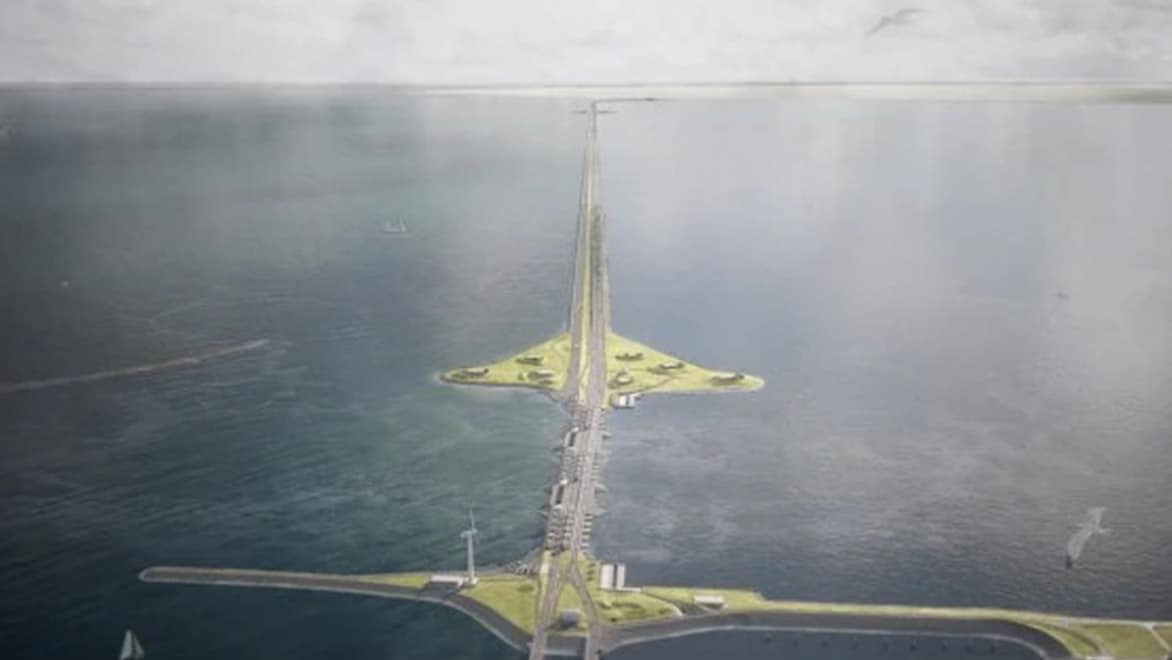LEVVEL
Weatherproof Infrastructure: Reinforcing the Largest Dike in the Netherlands with BIM
CUSTOMER STORY
Share this story
Project strengthens largest dike of the Netherlands
As more frequent "once-in-a-generation" storms and floods take a toll on vital infrastructure, many countries turn to forward-thinking design and engineering firms to improve their roads, bridges, and water systems. One such undertaking is the reinforcement and renewal of the Afsluitdijk.
For more than 85 years, the Afsluitdijk, a 32-kilometer dam has been a hallmark of Dutch hydraulic engineering. The dam protects a large portion of the Netherlands from the Wadden Sea and regulates the water level in Holland's biggest lake Ijsselmeer. The infrastructure project is a model of protective and preventative damage control, incorporating ecological and recreational components. It’s making huge strides in sustainable infrastructure. Project planners are relying on the latest technology to work collaboratively and efficiently to strengthen the enclosure dam, increase its capacity to discharge water, and build pumps to transport water into the sea.

Image Courtesy of Levvel (BAM & Van Oord)
First Steps: Making Multidisciplinary Collaboration Possible with BIM
Rijkswaterstaat, part of the Dutch Ministry of Infrastructure and the Environment, awarded the renewal project to Levvel, a consortium made up of Van Oord Aberdeen Infrastructure Partners B.V., BAM PPP PGGM Infrastructure Coöperatie U.A. and EPICo NL 2 B.V. The consortium is responsible for the design, build, finance, and maintenance, which began in 2018, and is expected to be completed in 2023.

Image Courtesy of Levvel (BAM & Van Oord)
Text-only; 1 column
The Afsluitdijk project is a complex multidisciplinary undertaking that involves numerous stakeholders. Its design is based on recreation, ecology, sustainability, and innovation and includes:
- Raising and strengthening the dike with 75,000 innovative level-blocks that will be placed on top of the current basalt cladding. The blocks weigh 6,500 kilos each and have been specially developed for the Afsluitdijk to protect the dike against waves, while accommodating sea life and plants.
- Reconstructing and expanding the lock complex at Den Oever with two large pumping stations, allowing more water to be drained from the IJsselmeer into the Wadden Sea.
- Creating a cycling path over the full length of the Afsluitdijk to increase the recreational use of the dam, while widening the emergency lanes to make the A7 motorway safer.
With more than 500 people from architecture, civil engineering, and construction working together during the design and preconstruction process, collaboration was paramount for the project's success.
“We needed to reimagine the design and preconstruction phase by using a common data environment to create a shared view of all activities, dependencies, deadlines, and inquiries, this would eliminate data silos, streamline review cycles, and extract real-time data for design coordination and review, quantity-take-off, and mark-ups.”
—says Yuri Grotewal, BIM Coordinator, Royal BAM Group
Text-only; 1 column
The complex nature of the Afsluitdijk project called for the right technology to solve these challenges. To develop an ecosystem that supports multi-disciplinary teams, Levvel deployed Autodesk Construction Cloud, the cornerstone of which has been BIM 360 and Assemble. The team uses the tools together for integrated 3D modeling to create a single source of truth for greater efficiency, collaboration, and improved communication.
“BIM 360 is at the core of our collaboration process and has the most prominent role in the project. The latest model data is always available in 3D and 2D and is easily accessible by all project stakeholders. Without BIM 360, collaboration would be a nightmare.”
—says Ronald Huizinga, BIM Manager, Arcadis
Speeding up the Process with BIM Tools
With the design team comprised of +/- 300 people, collaborating in a single environment was essential. Designers would upload models directly from Civil 3D and Revit into BIM 360 for design collaboration and coordination. Planners also used Dynamo and advanced scripting to speed up the design process, citing the tools' ability to increase collaboration and automated publishes, interactivity, and the ability to work simultaneously. This emerging technology already saves a lot of time on the project. By providing the ability to create computational design, designers can produce concepts that iterate faster and earlier.
Besides saving time, the intuitive workflow for reviewing models improves quality and insight. The digital model allowed designers to work on the project at the same time through iterative review rounds with issues and mark-ups. Prior to this workflow, traditional rounds of review could take up to five days. With BIM 360, reviews are closed in one day, which is an 80% reduction in time for design coordination.

Image Courtesy of Levvel (BAM & Van Oord)
Text-only; 1 column
BIM 360 Model Coordination also helps facilitate model coordination during the design phase. Nearly 200 members of the design staff and 30 modelers were able to effectively collaborate during the Afsluitdijk project, avoiding the potential for costly rework. The entire team was able to benefit from automated clash detection, enhanced insight into the number of clashes, and receive instant feedback on the state of the model and major clash groups through automatic grouping. “BIM 360 has become the beating heart of the design process within our organization,” says Huizinga.
Assemble is another key solution used by the team to condition, query, and connect BIM data to key workflows, using the tool’s ability to provide up-to-date visualization of the total project status. Through Assemble, various project stakeholders can gain access to the model, saving half of the time with every update of quantity take-off compared to the traditional workflow.
“Assemble is a great tool as it’s easy to use, regardless of BIM technology expertise. With Assemble, you can create your own structure of the BIM model and extract data for checks and quantity take-off. You can see which parameters are not filled, add the missing data, and push it back to Revit.”
—Says Douwe Bosma, BIM Specialist, Royal BAM Group
Driving efficiency with innovative workflows
With Assemble the team can easily, track, manage, and analyze model data. Multiple stakeholders can access Assemble to observe project quantities and stay up to date whenever a new model is published. This results in tremendous efficiency gains on a project of this magnitude, which will play a vital role in the long-term management of the project. Viewing the geometry objects based on a predefined structure with their quantities has never been this easy.
The team is implementing a variety of innovative workflows on this project. "We make state-of-the-art 4D impressions and animations to communicate with the client," Huizinga says, adding that the renders and animations are used to elaborate the build sequence and to give insight in the phasing. This speeds up not only the time to get permits from authorities but also helps communicating with the client.

Image Courtesy of Levvel (BAM & Van Oord)
Design for the Future
The grand scale of the Afsluitdijk reinforcement is unique for the Netherlands. It represents the latest developments in dealing with rising sea levels, water safety, ecology, and sustainability, while building a safe and secure dam using state-of-the-art design and building software.
The Autodesk aided design and analysis delivers 40,000 tonnes less CO2 emissions, a reduction of no less than 56% compared to alternative solutions. Each level-block of the dam receives a chip and is therefore easy to trace for maintenance. The blocks are transported via water and quickly assembled onsite with minimal footprint.
By exploring automation possibilities early in the project, the team was able to understand where to improve based on process and repetitive manual workflows, resulting in time savings, efficient collaborative methods, and measurable results – all hallmarks of this project. The team was able to connect the phases of construction, producing a high-quality model during design that aided in deploying the right tools during preconstruction to mitigate errors downstream.

Image Courtesy of Levvel (BAM & Van Oord)
Text-only; 1 column
By using the most state-of-the-art risk management, sustainable construction methods as well as proven Autodesk technologies, it is expected that the dam will withstand a once-in-every-ten-thousand-year storm.
Fittingly, it was named one of the finalists in the AEC Excellence Awards 2019 in Infrastructure Design.







